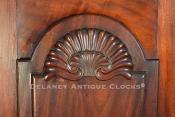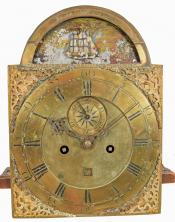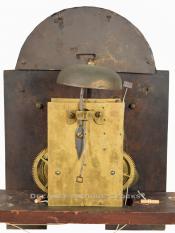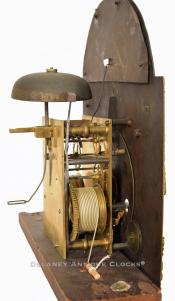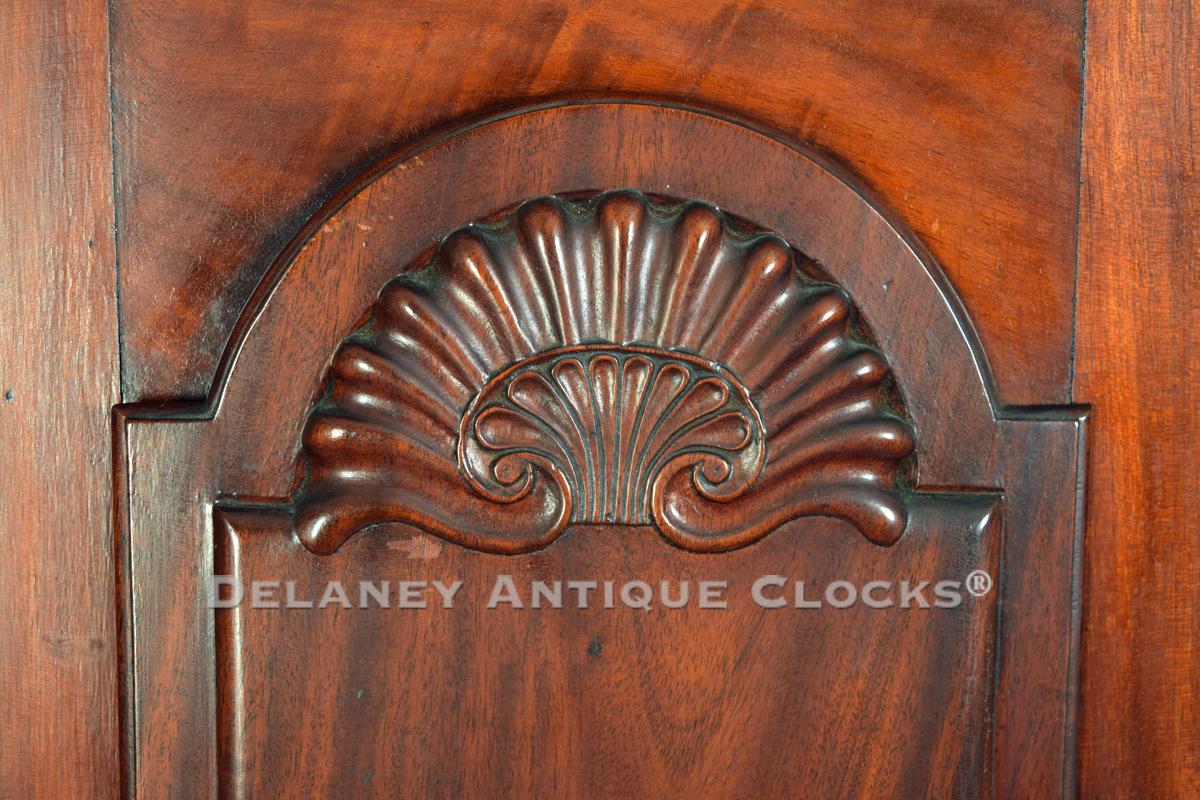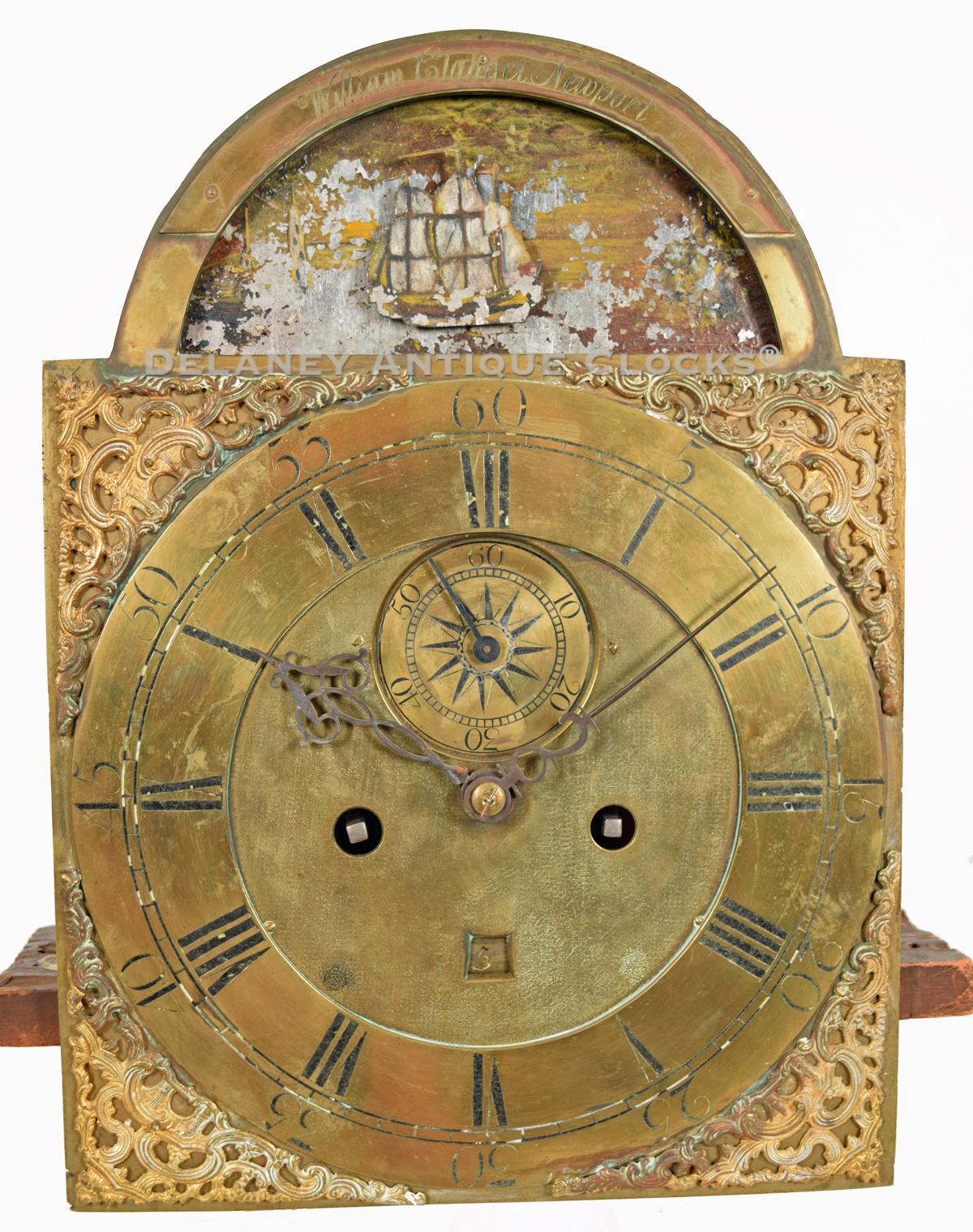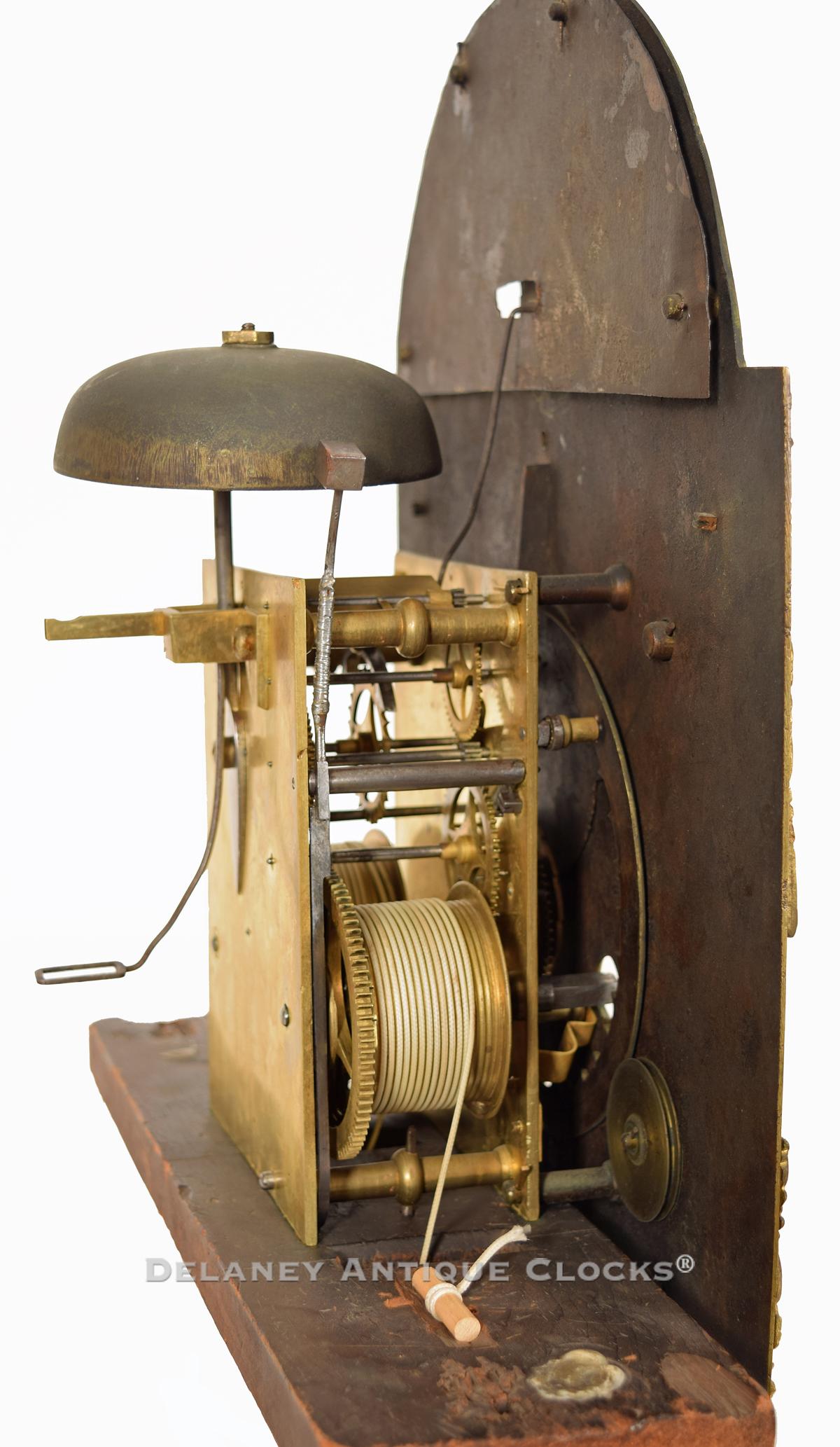A Rare Chippendale carved block and shell mahogany Tall Case Clock, by William Claggett, of Newport, Rhode Island, made circa 1745. This fine example features an automated rocking ship dial. 222059.
This rare mahogany tall clock is a good example of Newport, Rhode Island's high-style clocks produced during the middle of the eighteenth century. The choice of wood, stately proportions, and subtle details are indicative of the fine clocks made during this early period. This attractive clock was produced by the colonial Clockmaker William Claggett [1696-1749]. William was Newport, Rhode Island's first and most prolific Clockmaker. He was father to Thomas Claggett and father-in-law to James Wady. Both of which are considered prominent Newport clockmakers. These rare early clocks, produced by William, are prized by collectors as some of the finest examples of early American clockmaking. This example survives in good condition and retains an older surface on both the dial and the case.
This composite brass dial is wonderfully detailed and retains a mellow old patina. The dial measures 12 inches across and is composed of a brass sheet decorated with applied brass decorations and skillfully executed engravings. The most exciting feature is the automated rocking ship display in the lunette. A fully rigged painted tin ship is depicted sailing across the water. This ship moves or gently rocks from side to side with the pendulum's motion. Behind it is a painted scene that has experienced some loss. One can make out the sails of an additional ship in the background. Above this, rivetted to the arch frame, is a brass plate engraved with the Clockmaker's signature and working location. It reads, "William Clagget – Newport." Several other Claggett clocks are known with this single "t" spelling. The four rococo-themed corner spandrels are mounted to the dial sheet with a screw from the back and frame the applied time ring. The engraved time or chapter ring was originally finished in a silver wash. This has not been restored and is currently in as-found condition, which should appeal to the purest of collectors. It is formatted with Arabic-style five-minute markers. A closed minute ring separates the five-minute markers from the large Roman-style hour numerals. The surface of the dial inside the chapter ring is textured or matted. Here, a four-sided display window for the calendar day and an inset subsidiary seconds dial. This is decorated with an engraved star that features twelve points. Additional Arabic-style numerals are used to mark the ten-second positions here. The hour and minute hands are wonderfully hand-filed. The skill exhibited here is very high.
The two-train movement is brass, eight-day duration, and is of good quality. Four-turned pillars or posts support the two large brass plates. Hardened steel shafts support the polished steel pinions and brass gearing. The winding drums are grooved. The escapement is designed in a recoil format. The movement is weight driven and designed to run for eight days on a full wind. It is a two-train or a time-and-strike design having a rack and snail striking system. As a result, it will strike each hour on the hour. This is done on a cast iron bell which is mounted above the movement.
This case form is one we have seen before. We recently sold a clock that featured a movement signed by the Providence Clockmaker Edward Spalding. The case form and carving are very similar to the one presented here. It is constructed in high-quality mahogany and was likely produced in Providence. The case is elevated on four slender ogee bracket feet applied to the bottom of the base molding. The base section is somewhat compressed. An ogee-shaped molding transitions the base to the waist section. The waist is long and narrow and is fitted with a convex block-and-shell waist door. The carved shell ornament at the top is a wonderful and desirable furniture detail. The quality of this shell carving suggests the origin of one of Newport or Providence's leading mid-eighteenth-century cabinetmakers, illustrating the work of one of the first-generation or early second-generation Townsend and Goddard shops. This door opens to access the two drive weights and the brass-faced pendulum bob. The hood or bonnet slides onto the cove-shaped waist molding. It is designed with four free-standing columns that visually support the upper pediment. These are wonderfully detailed, slightly tapered, and terminate at both ends in shaped wooden capitals. The small arched molding above the hood door is separated from the complex molding above it by a plain tympanum. The upper molding features several profiles. Above this are three carved wooden finial plinths and a pierced and open fretwork pattern. Three brass urn-shaped finials are mounted onto the wooden plinths. All of this decoration above the arch molding is a later addition to the case.
This case measures approximately 101.5 inches tall. At the upper hood molding, it is 21.25 inches wide and 11.25 inches deep. This clock was made circa 1745.
Inventory number 222059.
William Claggett is included in Patrick T. Conley's Rhode Island's Founders from Settlement to Statehood. Conley's book, written in 2010, lists 57 names of the most historically significant members of the State of Rhode Island. Claggett is the only clockmaker to be included.
William Claggett was a clockmaker, watchmaker, compass maker, organ builder, engraver, printer, lecturer, author, and scientist.
William Claggett is considered one of America's earliest clockmakers. He is thought to have been born in Wales in 1696. He came to the Colonies, first to Boston sometime before 1714. He was married by Cotton Mather to Mary Armstrong on October 21, 1714. She was the daughter of Mathew and Margaret Armstrong. Their marriage record exists. In 1715, he placed his first advertisement in which he identified himself as a "Clock-Maker near the Town-House." By 1716, he had moved to and settled in Newport, Rhode Island, until his death in 1749. Here he was admitted as a Freeman. His original house still stands and is located at 16 Bridge Street. This is not true of his shop, which was located to the west of the Brick Market. This building was demolished after his death in order to make access to Long Wharf. His neighbors included the brothers Job I and Christopher Townsend, both of whom were cabinetmakers. It appears Mary died sometime around 1727. William then married his second wife, Rebecca, and she was named in his will. It should also be mentioned that William had at least five children. His son Thomas, born in 1730 and died in 1767, was also a clockmaker. William's daughter Mary married James Wady of Newport. James Wady was also a clockmaker. Two other daughters, Hannah Threadkill and Elizabeth Claggett, and a son Caleb are also mentioned in William's will.
William was civic-minded and was a member of the 7th Day Baptist Congregation as well as a founding member of Newport's local fire company. He kept close ties to Boston, and we also know that he had other interests. He was a talented engraver. So much so that he printed paper money for the state of Rhode Island in 1738. He was a merchant, as well as an author. He manufactured musical instruments and was a dabbler in science and electricity. In 1746, he put on a public exhibition of electricity. The electricity was produced and displayed by a machine he made. William performed a similar demonstration in Boston the following year. Interestingly, he gave the monies generated from these exhibitions to charity. It is also thought he introduced Benjamin Franklin to this science. Indeed, William had a first-rate mind.
Examples of his work demonstrate his ability to make high-quality clocks. Today, very few examples are known. It is well documented that he built the original tower clock for the Trinity Church. The Redwood Library & Athenaeum in Newport is the oldest lending library in America. It has an example of a tall clock that was donated to them in 1948 by Bishop Samuel Babcock, who was a descendant of the original owner, the Staton family. This clock was thought to have been made in 1723. A second clock, a wall clock made circa 1732, is at the 7th Day Baptist Meeting House. This clock is thought to have been the earliest wall clock made in America.



